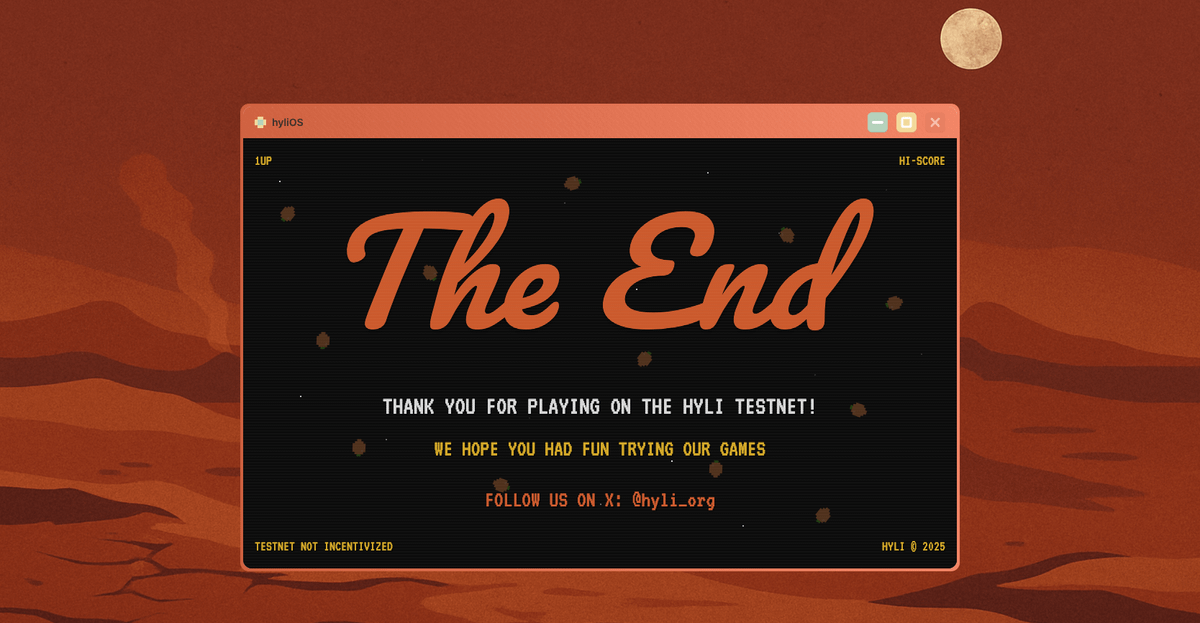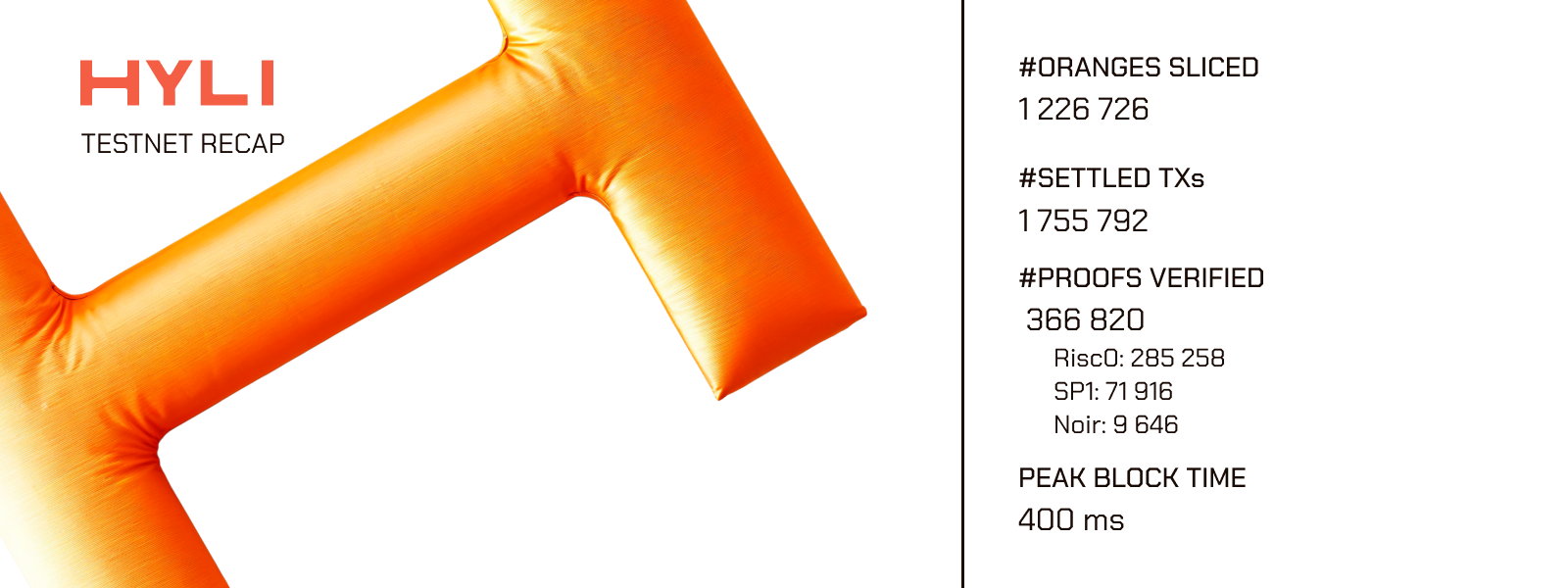Testnet retro: a small slice for you, a giant leap for Hyli!
We’ve just wrapped up our first public testnet event, and here’s everything we learned from building, scaling, and proving it under real-world conditions.

On June 16, 2025, Hyli launched a Mars-themed testnet event. Our goal was to build a suite of engaging and playful apps that would work in production and showcase exactly how Hyli works, while testing the network load and making scalability improvements in real-time conditions.
The campaign was our first real-life test of several key components of Hyli, including native proof verification, pipelined proving, proof composition, and integration with prover networks.
This Mars-themed campaign lasted for a month and helped us learn a great deal about our own blockchain. We’ve closed the apps for good, but the testnet remains live and permissionless, allowing all developers to build and deploy apps on our testnet.
Before we begin, we would like to thank everyone who joined us on this adventure. We’re grateful for the memes, the timeouts, and for your relentless orange slicing.
In this post, we’ll do a general retrospective of our testnet. If you're looking for app-specific insights, we recommend checking out the per-app deep dives we published on our blog in June and July.
At a glance: the testnet in numbers
Here's what our testnet looked like by the numbers, excluding our special Faucet Ninja event at the end of the campaign:

In just four weeks, users sliced over 1.2 million oranges, settled 1.7 million transactions, and generated over 360k unique proofs using three different proving systems!
Everything is proven
The proof systems we used
Everything on the Hyli testnet was proven. Following our concept of pipelined proving, all transactions were first sequenced on the Hyli DA layer, then verified according to their proof system after being proved.
- SP1 powered the real-time games like Orange Trail and the Crash minigame.
- Risc0 was used for tokens like $ORANJ and in eZKasino to prove randomness.
- Noir handled wallet authentication, keeping your passwords private.
For all SP1 proofs, we relied on the Succinct Proving Network, while Boundless was leveraged for Risc0; the Noir proofs were all generated client-side and served as a natural rate-limiter for signups.
Hyli verified all of those and settled the verified states onchain, running eight validators across three continents.
Proof composition in action
No recursion, no headaches. Thanks to Hyli’s native proof composition, we verified all of these proofs in a single transaction when needed.
Here are some examples of how proof composition worked on Hyli:
- Cross-app: You could burn three different tokens to play with your Hyligotchi. Each app is built on the shared state of the others with one wallet to unite them all.
- Cross-scheme: The faucet was built in SP1. But each orange you sliced earned you $ORANJ, proven in Risc0.

Merklization: When is it worth it?
The state of most applications was stored onchain as a Merkle tree to reduce storage footprint and increase efficiency. This merklization had two goals:
- Optimize proof size for most apps.
- Enable partial updates: especially useful in Hyligotchi, where every pet had its state.
Merklizing an application’s state means that proofs have a fixed size, and therefore a fixed cost. We had to determine when this fixed cost became worth it compared to the variable proving cost, which scales with the number of users.
For the faucet, the threshold was approximately 600 active wallets. Once we surpassed that number, the benefits of merklization began to pay off. We recommend building with this optimization in mind if you anticipate strong usage for your app.
What we learned about proving infrastructure
The main bottleneck in our system wasn’t consensus; it was proving. The Faucet Ninja open event really showed that!
The more prover networks we onboard, the more transactions we can handle in parallel. This enables horizontal scalability: the more provers and validators there are, the faster the network becomes.
During the Faucet Ninja finale, we saw just how fast Hyli could go without prover delay.
Meanwhile, pipelined proving provided a smooth UX across the campaign: you could slice an orange and see your balance increase instantly. The proof was generated in the background and settled later. That’s how we combine the security of Web3 with the feel of Web2.
Going out with a bang: the Faucet Ninja special event
To close out the campaign, we ran a two-day event with all restrictions lifted. There were no more invite codes, and no proof required: we ran with dev-mode proofs to simulate instant proving and test Hyli’s consensus and data availability in perfect conditions.
This is our glimpse into the future: what Hyli will feel like when tech advances bring us to real-time proving.
It marked the end of the player-facing campaign, and it gave us our highest-ever throughput.

What’s next for Hyli?
This campaign taught us a lot, and we’re proud of what we shipped. Now, we’re back in building mode… and it’s your turn to create whatever you can think of.
We’ve sunset the apps. Now, if you visit hyli.fun and log in with your wallet, you’ll see your « testnet wrapped » recap. Take a look!

The testnet itself is open and permissionless. We’re updating our developer documentation to support developers and teams who want to build and deploy on Hyli. The goal is to help you create things without needing our support or permission: the testnet network will be permissionless, and our documentation will include all the information you need to transition from «I have an idea » to «my app is live and ready to share ».
If you need help, our Telegram group is open, and we strive to answer tech questions. And if you miss your favorite app, they’re open source: clone them and bring them back!
We wanted to prove that a radically different approach to blockchain was not only possible, but also enjoyable.
We think we’ve succeeded. Now, we’re excited to see what you’ll build.
With Hyli, you can just build things.

